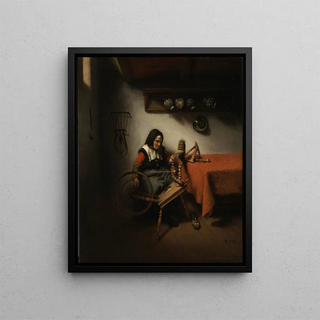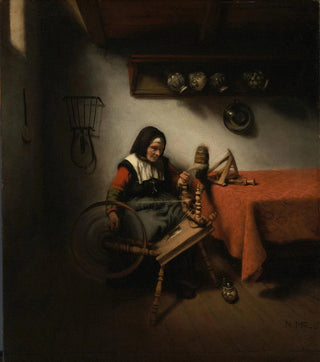Art print | Old woman spinning - Nicolaes Maes


View from behind

Frame (optional)
In the fascinating world of Dutch baroque art, Nicolaes Maes's "Old woman spinning" art print stands out for its profound humanity and intimate atmosphere. This painting, capturing a moment of everyday life, transports the viewer into a modest interior where the simplicity of gestures reveals an invaluable emotional richness. The scene depicts an elderly woman, focused on her spinning work, evoking patience and wisdom accumulated over the years. Through this artwork, Maes invites us to contemplate the beauty of ordinary activities, often overlooked in the hustle of modern life.
Style and uniqueness of the work
Nicolaes Maes's style is characterized by striking realism and meticulous attention to detail, which are fully expressed in "Old woman spinning". The soft, warm light floods the scene, creating a play of shadows and highlights that gives the canvas an almost tactile dimension. The textures of the clothing, the skin marked by time of the protagonist, and the surrounding objects are rendered with remarkable precision, demonstrating the artist's technical skill. This art print, far from being a simple representation, is a true psychological study, where the gaze of the elderly woman, both serene and contemplative, invites reflection on the passage of time and the value of manual work. Maes succeeds in establishing a dialogue between the subject and the viewer, making the work timeless.
The artist and his influence
Nicolaes Maes, a pupil of the famous Rembrandt, managed to establish himself in the 17th-century artistic landscape through his unique approach to genre painting. Although less well-known than his master, Maes developed a personal style that combines chiaroscuro with a particular sensitivity to human emotions. His work reflects the evolution of artistic themes of his time, highlighting domestic life and human relationships. By incorporating elements of everyday life into his compositions, Maes paved the way for future artists who would explore these subjects further. His influence is felt in the work of many subsequent painters, who sought to capture the beauty of daily life with the same depth and refinement.

Matte finish

View from behind

Frame (optional)
In the fascinating world of Dutch baroque art, Nicolaes Maes's "Old woman spinning" art print stands out for its profound humanity and intimate atmosphere. This painting, capturing a moment of everyday life, transports the viewer into a modest interior where the simplicity of gestures reveals an invaluable emotional richness. The scene depicts an elderly woman, focused on her spinning work, evoking patience and wisdom accumulated over the years. Through this artwork, Maes invites us to contemplate the beauty of ordinary activities, often overlooked in the hustle of modern life.
Style and uniqueness of the work
Nicolaes Maes's style is characterized by striking realism and meticulous attention to detail, which are fully expressed in "Old woman spinning". The soft, warm light floods the scene, creating a play of shadows and highlights that gives the canvas an almost tactile dimension. The textures of the clothing, the skin marked by time of the protagonist, and the surrounding objects are rendered with remarkable precision, demonstrating the artist's technical skill. This art print, far from being a simple representation, is a true psychological study, where the gaze of the elderly woman, both serene and contemplative, invites reflection on the passage of time and the value of manual work. Maes succeeds in establishing a dialogue between the subject and the viewer, making the work timeless.
The artist and his influence
Nicolaes Maes, a pupil of the famous Rembrandt, managed to establish himself in the 17th-century artistic landscape through his unique approach to genre painting. Although less well-known than his master, Maes developed a personal style that combines chiaroscuro with a particular sensitivity to human emotions. His work reflects the evolution of artistic themes of his time, highlighting domestic life and human relationships. By incorporating elements of everyday life into his compositions, Maes paved the way for future artists who would explore these subjects further. His influence is felt in the work of many subsequent painters, who sought to capture the beauty of daily life with the same depth and refinement.






